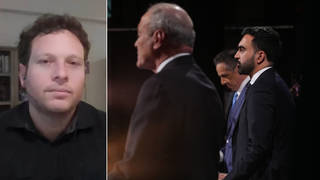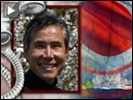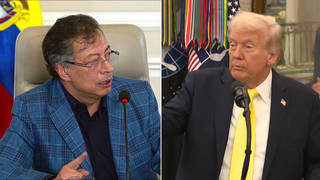
Guests
- Arnie Gundersennuclear industry executive for many years before blowing the whistle on the company he worked for in 1990, when he found inappropriately stored radioactive material. He is now chief engineer at Fairewinds Associates.
- Aileen Mioko Smiththe director of Kyoto-based Green Action. She is one of Japan’s leading voices challenging the production, commerce and transport of nuclear material, and calling for sustainable energy policies.
Japanese anti-nuclear activist Aileen Mioko Smith and nuclear engineer Arnie Gundersen question whether Japanese officials are doing enough to protect civilians from radiation, including proper monitoring and widening the evacuation zones. Some 70,000 residents have been forced to evacuate their homes, and another 140,000 people have been ordered not to step outside. “You can’t protect the people from reality,” Smith says. And Gundersen says, “If I were in Japan, I would at least get the children away from the reactor, because their bodies are growing faster and their cells are more susceptible to radiation damage. I would go out to 50 kilometers and at least get the children away from those reactors.” [includes rush transcript]
Transcript
SHARIF ABDEL KOUDDOUS: We go right now to Aileen Mioko Smith. She’s the director of Kyoto-based Green Action. She’s on the board of Greenpeace International. She’s joining us from San Francisco right now, one of Japan’s leading voices challenging nuclear power.
Welcome to Democracy Now!
AILEEN MIOKO SMITH: Thank you very much.
SHARIF ABDEL KOUDDOUS: Can you tell us what you understand is happening right now in Japan in terms of the evacuation?
AILEEN MIOKO SMITH: Yes. By the way, I’m not a board member of Greenpeace International. I’m working with Green Action in Kyoto, Japan.
Right now, the evacuation is underway, and we’re very concerned about the people around the plants. I think that what we’re suffering very much right now in Japan is that the government only said a evacuation area within 10 kilometers, or six miles, was necessary. So, there’s nothing on the books about any evacuation to be undertaken beyond that limit. And I think that we are right now suffering from the fact that nothing was on the books to evacuate people beyond that area. I agree with Arnie Gundersen, what he just said, that evacuations should be a larger area right now. Thirty kilometers is not enough. That’s 18 miles. It’s not sufficient. It should be going on beyond that right now, so that people can be prepared for wider areas of radiation contamination.
We’re very concerned with the complete lack of environmental monitoring around the region where people are evacuated and where people need to be evacuating even further. And that was a concern of Japanese citizens way back. This plant, from the very start, even before it was built, citizens said that the land was not proper for building a nuclear power plant. There was opposition. There were lawsuits. And of all — in all the areas, 54 nuclear power plants in Japan, every area, citizens have fought siting, because of seismic concerns. So this is very much a man-made problem. People may think it’s a combination of man-made and human — natural disaster, but no plant should have been here in the first place.
SHARIF ABDEL KOUDDOUS: Japan’s policy right now is to build eight more nuclear plants. What do you understand is happening with that right now?
AILEEN MIOKO SMITH: Well, right now, just the day before this accident happened, people were — citizens who had been opposing a plant site for 30 years down in Yamaguchi Prefecture, southwest of Osaka, were actually virtually in hand-to-hand combat with people who — with the utility who was coming in and trying to start a landfill in order to build a plant. Of the eight sites, they’re still supposed to be under construction and be built, but obviously that situation would change as of this week.
SHARIF ABDEL KOUDDOUS: And the information coming right now from the Japanese government, very little information, what do you understand they’re saying or they’re not saying?
AILEEN MIOKO SMITH: Well, I think that there are three things. One is that they themselves don’t really know what’s going on. But the other is, I think that they are trying to protect the public. I think it’s very important not to panic people, so the tone, which is very calm, is good and should remain that way. But they should be informing the public exactly all the things that they know and exactly all the things — admit to all the things that they don’t know. And I don’t think that they’re informing the public. I feel like — we really feel that the government is patronizing of the citizens. You can’t protect the people from reality. The reality is that the situation is very serious, and emissions could become much greater.
And I think that the public really needs to be warned that, carefully, and that evacuations should be leading the situation, not like the situation is really bad and then you delay and delay but then you evacuate a little bit. Actually, what you should be doing is initially start the evacuation and be quite proactive about it, and evacuate ahead of the problem versus evacuating as a result of things that have happened. And that’s not happening right now. So I think that they have to be very quick right now in initiating calm evacuation of a larger area.
SHARIF ABDEL KOUDDOUS: I want to turn back to Arnie Gundersen for a moment now, joining us from Burlington, Vermont. What is the significance of the removal of 750 workers from the nuclear plant? How will this affect the effort to prevent a meltdown?
ARNIE GUNDERSEN: It’s got to make the efforts worse. You know, these 750 people that are being evacuated were doing critical work. They weren’t sweeping floors and washing windows; they were doing critical work. So, when the staff, basically, is cut — 90 percent of the staff is told, “You have to leave the site” — that’s an indication that a lot of critical work isn’t getting done. I really think it’s also — it’s an indication that management at the site has thrown in the towel and is going to let this thing run its course without any more human intervention. What that means is that — I’m particularly concerned about another aftershock, especially if an aftershock — on the weak Unit 2 containment, which already apparently has failed, and an aftershock would make it worse. The other thing that especially concerns me is that a large group of personnel were fighting the fire in the fuel pool on Unit 4, and again, you can’t have 60 people on a six-unit site and expect that anything gets done.
SHARIF ABDEL KOUDDOUS: There was the disaster at Three Mile Island, the Chernobyl disaster. This is a disasters of a different sort. There’s been three explosions. Are we in unchartered territory right now?
ARNIE GUNDERSEN: This is certainly right now bumping up against the magnitude of Chernobyl. It’s clearly passed what happened at Three Mile Island. And it’s not clear that this situation may not get worse, not better. You know, Chernobyl was one reactor. There are three in either partial meltdown or meltdown. And then the other one has a fuel pool fire. And I understand this morning that the temperatures in the other two fuel pools are also increasing. So, you know, I’ve said before that this could easily become Chernobyl on steroids. It’s not there yet, but given that the essential personnel have been evacuated, it could easily get there within 24 hours.
SHARIF ABDEL KOUDDOUS: And the issue of plutonium, Arnie Gundersen?
ARNIE GUNDERSEN: Yeah, you know, plutonium is named after Pluto, the god of Hell. And that’s an indication that it’s a pretty nasty element. It’s in all these reactors. Unit Three was using what’s called mixed oxide fuel. So Unit Three had more plutonium than the other units. But all of these reactor fuel pools and the nuclear reactors themselves have plutonium in them.
When plutonium volatilizes, when it gets hot and turns to a vapor, it can be breathed in. And, of course, it’s very — it can cause cancer in lungs very, very easily. And the containments, which are designed to contain this plutonium, are — have failed, at least in Unit Two. I believe in Unit One and Three, they are leaking, but they probably haven’t failed. So, it is likely that volatile plutonium is being released right now.
SHARIF ABDEL KOUDDOUS: Finally, Arnie Gundersen, what is most important for people to understand as they follow the news in these coming days?
ARNIE GUNDERSEN: I guess if I were in Japan, I would at least get the children away from the reactor, because their bodies are growing faster and their cells are more susceptible to radiation damage. I would go out to 50 kilometers and at least get the children away from those reactors.
You know, Japan is a long way from the U.S. There’s 5,000 miles of ocean for that plume to disperse over. So, it’s a little bit too early to determine what the health effects are on the United States. But it’s clear to me we will detect it. Within about five to seven days, the plume will hit the West Coast, and we’ll begin to detect the radiation. Exactly what the magnitude of the radiation is, as your previous caller said, there’s not any good environmental monitoring. There’s no monitoring in the plant, because, one, there’s no people, and, two, the instruments have blown up. So, we just simply don’t know how much radiation is getting out. I think the numbers we’re seeing now are on the low side, and they don’t really represent the true magnitude of what’s already happening.
SHARIF ABDEL KOUDDOUS: I’d like to end with Aileen Mioko Smith. You’ve been in touch with many people in Japan. Talk about the recovery efforts right now — in the north, there’s bodies washing ashore, there’s millions without food or power — as this nuclear crisis is unfolding.
AILEEN MIOKO SMITH: Yes, that’s correct. All the people that we know in Fukushima and Miyagi, we haven’t heard from them. In, finally, the last day and a half, we received, like, a phone call, where it’s just an instant. You can hear a voice for a split second, and you know that the person is alive.
These are all people who were fighting and concerned about the seismic safety of the Fukushima plants. Actually, the last two years, there was a review of all the seismic situation at the nuclear power plants, whether the land was safe and the facility, the nuclear power plant, was strong enough to withstand quakes. And just the last few months, the last few weeks, citizens had pointed out that TEPCO’s analysis was insufficient, and the government should not approve TEPCO’s analysis, but the government approved it. And these are the citizens that are now — I don’t know, some of them, if they’re alive or not.
The areas, the towns — we know people in all those towns. And you look at the photograph of the town, and it’s just completely devastated. I just completely believe that we would hear from all of them, and it was just a matter of time of hearing from them, but when you look at their towns, you know, you’re not sure, if you haven’t heard from them yet, whether they’re alive. So, they can’t — they can’t fight this situation now at the plant. All the people who were the spokespeople, who knew about the problems with the plant and the land there and the problems, they are all evacuated, or I don’t know if they’ve survived. And here we are — we’re the other spokespeople that lived further away, knew them, and are trying to speak on their behalf. And that’s where it is.
I was at the Fukushima plant last August with Kevin Kamps from Beyond Nuclear, based in Washington, D.C. We were there to warn about the dangers of spent nuclear fuel. I remember standing there with one of the people in Fukushima and looking down on the Daiichi plant on one side and the Daini plant on the other, and we took a photograph there, the three of us. And we met with the mayor of Futaba town, and also we were with — Kumano town, and also we went to Futaba town. These are two villages that are now completely evacuated.
We had independent scientists go in there three days ago, and they went in there to monitor. These are independent journalists that went with monitors to the actual towns that were evacuated. And all their radiation monitors went off. You could — they walked into the hospital of the town, and you could see that the evacuation was really rushed. They said that beds were turned over. Equipment, tubes for injections and everything was scattered all over the place. It was obvious people had left in a big hurry from the hospital. And when they went to the town hall, it was completely evacuated, and the levels just went off. So, they’re right now monitoring.
This person — as I was coming here to the studio, he was monitoring 50 kilometers, 30 kilometers from the plant and getting readings and putting it on the blog. I mean, this is the kind of information the government should be telling the people, but they don’t have the monitoring, because beyond 10 kilometers, radiation wasn’t supposed to leave. Every site in Japan, citizens have said, “Look, why do you say radiation stops immediately at 10 kilometers?” You know, it doesn’t, and you have to have a plan for if the radiation goes beyond 10. And the government, the national government, refuses to do this, and therefore, the prefectures didn’t get a plan. We’ve been to our prefecture over and over again about this.
SHARIF ABDEL KOUDDOUS: Well, we’ll continue to —
AILEEN MIOKO SMITH: One of the problems that we have is that —- yeah, we have plans for earthquake -—
SHARIF ABDEL KOUDDOUS: We’re going to continue to follow this story over the coming days. Aileen Mioko Smith, we have to leave it there.
AILEEN MIOKO SMITH: OK.
SHARIF ABDEL KOUDDOUS: We’re going to continue to cover this story very closely in the coming days. Aileen Mioko Smith is the director of the Kyoto-based Green Action, on of Japan’s leading voices challenging the production, commerce and transport of nuclear material. And thank you very much to Arnie Gundersen, a nuclear engineer who’s coordinated projects at 70 nuclear power plants around the country.












Media Options